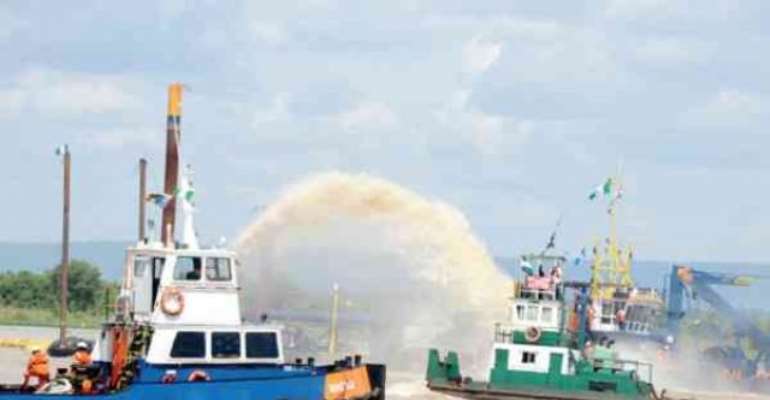DREDGING THE RIVER NIGER IS HALF COMPLETED

Ini Ekott
March 25, 2010 05:00AM
Dredging of the lower river Niger in progress in Lokoja after the launching by President Umaru Yar'Adua
The long dredging of the lower River Niger, which is expected to pass through 152 riverine communities at a huge N36 billion, is half completed, Ahmed Aminu, the Managing Director of the Nigerian Inland Waterways Authority (NIWA), disclosed on Wednesday.
Mr. Aminu told a House of Representatives team that the 572 kilometers project started by President Umaru Yar'Adua, has progressed at a steady speed and has left no significant negative impact on the marine ecology and the adjoining communities.
With the development, he said, barges and small ships of 3000 metric tons can now sail from Warri in Delta State, to Baro in Niger State.
“The former Minister of Works (Mr. Ibramin Isa Bio) had said that it is about 60 per cent completed, but that was an estimate,” he said.
“Work on Lot 2, from bifurcation of Nuns River and Forcados, to Onitsha and Lot 4, from Idah to Jamata, is about 80 to 90 per cent completed,” he told the members of the South-South Parliamentary Caucus of the House of Representatives, led by Andrew Uchendu, which said it met with the managing director to appraise the progression of the project.
He said that the project is divided into five lots, but that on the average, about 50 per cent is completed. He also disclosed that NIWA is still working on the inland ports that would facilitate cargo handling and sundry commercial activities.
On the impact of the dredging on the environment, he told the caucus that “there is no way the dredging would affect the inflow and outflow of its tributaries, since the dredging is not done with embankments.”
“The project is being undertaken under the strict terms of the Environmental Impact Assessment (EIA) carried out in 2002.
“So far, we have not heard any complaint from any community, because the dredged materials, except in Lokoja, are usually dumped 300 metres from the dredged channels. And you know that the Niger is on the average about a kilometre wide. So the materials are still dumped into the river,” he said.
